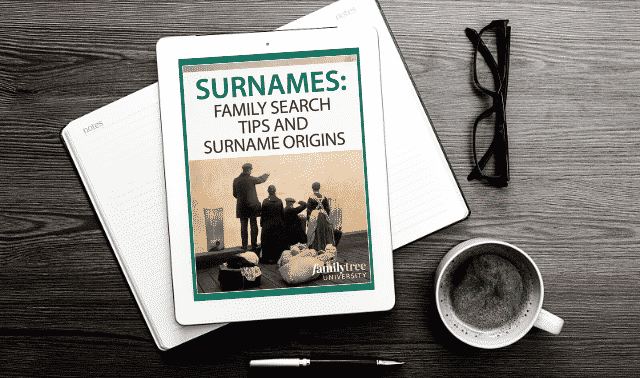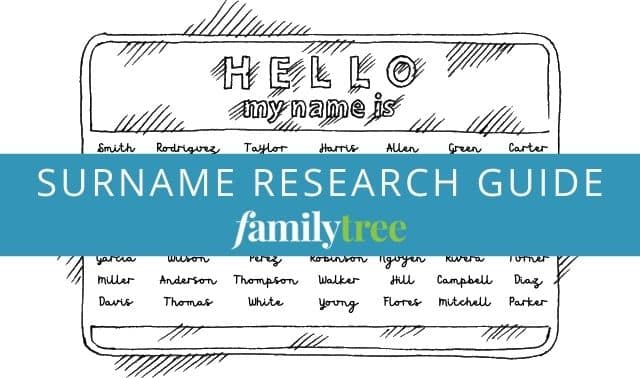
This free ebook contains some of Family Tree Magazine’s best genealogy tips relating to family names, including articles on basic surname research strategies, tips for seeking ancestral maiden names, what your surname reveals about your ethnic heritage, how to refining Google surname searches, and what you can learn by understanding surname meanings. Together this collection stands as a comprehensive guide to sorting out the surname snags in your family search: Surnames: Search Tips and Surname Origins.
Get Your Free Genealogy Forms
"*" indicates required fields
Tips for Sorting Out Common Surnames
Surnames are the skeleton key of the genealogy world. Enter them into a search field on Google, Ancestry.com, FamilySearch.org or any number of family research sites, and they can unlock discoveries from birth records to gravestones, census records to naturalization papers.
But ancestors’ surnames often lead to more questions, too. Try searching for common names such as Smith, Brown and James, and you’ll find yourself buried in search results. For the females in our family tree, tracking down maiden names can be a constant struggle. That’s why we’ve done our best to help out by providing you with this free ebook full of hints and strategies for searching family surnames.
So there are 31,139 John Smiths in the 1900 US census—and your ancestor, unfortunately, is one of them. How will you ever find the right guy? We all have ancestors with common names. And if you don’t think you have any, as soon as you start hunting for a particular person, you’ll find out just how common his name was.
Not to worry. You can take these three steps to ensure the John Smith in a given record is your John Smith:
- Learn as much identifying information about your ancestor as possible.
- Anchor him with someone who has an uncommon name.
- Make a chronology of his life events.
Here’s how it works for your John Smith: He lived in Illinois, limiting the possibilities to 1,719. You’re sure he was in Chicago, Cook County—only a mere 537 John Smiths listed there. Lookin’ better. Narrowing the search even more, you enter his birth year of 1867. Only 13 match. But the clincher to identifying your John Smith is his wife’s name: Bronislava Smith.
Looking at another example, the surname Riggs ranked 886th of the 1,000 most common US surnames in the 1990 census. But finding just two or three John Riggses living in Accomack Co., Va., in the 1700s makes the name common in your research.
You use all three strategies to help sort them out. First, you find your “anchor” for the John you want in his wife’s rather unusual name, Jemima Melichop. Anytime John appears in a record mentioning Jemima or the Melichop family, you know you have the right John Riggs.
The next strategy is learning more about each of the John Riggses than they probably knew themselves. Do this by searching original land and tax records. No two men own the same property at once, or are taxed on the same horses, cattle and watches. So the details in these records become like fingerprints for a person with a common name.
Finally, make a chronological table of events for each John Riggs and scrutinize all the dates. You should feel pretty comfortable concluding that one of them, who died in 1830, almost certainly wasn’t the same man taking someone to court 11 years later.
What’s inside the Surnames: Search Tips and Surname Origins ebook?
Claim your copy of Surnames: Search Tips and Surname Origins to get five guides that will help you unpuzzle the origins, meanings and clues within your family names.
Guide #1: 4 Keys to Surname Origins and Meanings
How are you supposed to trace your family’s history if the names keep changing from generation to generation? Surnames are among the most important—yet most potentially puzzling—clues to your family’s past. You think you’re researching the Santos family and suddenly you’ve got Maria Maria. Or your ancestor Sven Andersson’s son is named Magnus Svensson. To deal with such challenges and to make the most of the answers that surnames can suggest, it helps to know and understand the naming practices in the cultures and geographies of your ancestors. From patronymics to place names, treat this article as a decoder for your ancestral last names.
Guide #2: Seven Strategies for Surname Research
Have you ever wondered what it would’ve been like to do genealogy in the days before surnames? Amazingly, surnames didn’t come along until fairly recent times. In Britain, for example, they weren’t common until the 12th to 14th century, and even then the practice wasn’t universal. Many European Jews began using surnames only when it was mandated in the late 18th and 19th centuries. We genealogists, of course, are glad our families finally adopted these identifiers—they make sorting out the Herberts and Normans and Roberts much easier. But surnames’ value to family historians doesn’t stop there. Open the door to even more genealogical finds by using these seven surname strategies.
Guide #3: How to Construct Google Surname Searches, Step by Step
Unless you have Axelquists or Birtwistles in your family tree, your Google surname searches probably produce oodles of irrelevant hits. Web searching becomes especially frustrating if you’re tracing ancestors with common or “search-unfriendly” surnames—monikers that double as other common words, such as colors (White), geographical formations (Hill) and buildings (Church). Fortunately, you can solve this problem using Google’s “search engine math” (so-called because of its resemblance to algebraic equations). Using the tricks shown in this tutorial, you can construct queries that work like magic, turning those irrelevant hits into a new set of genealogical discoveries.
Guide #4: 10 Sources to Find Female Ancestors’ Maiden Names
Every family historian runs into trouble at one time or another while researching a female ancestor whose maiden name—the key to unlocking previous generations—seems nonexistent. Especially prior to the 20th century, finding foremothers is complicated by the fact that women dumped their last names at marriage for their husband’s surnames, often didn’t own property and generally left fewer historical records than men. Never fear: We’ve laid out a treasure map of 10 places to look for keys to your female ancestor’s past.
Guide #5: Country-by-Country Guide to Naming Customs
In today’s America, where children are named after reality-show stars and parents christen their offspring Khaylee and Jaxon, it’s hard to imagine such a thing as naming traditions. But not that long ago, parents routinely followed patterns for passing on given names from generations past. The traditions varied by country, but if you know your cultural heritage, you often can use these patterns to make educated guesses about the brick walls in your past. Take a look at traditional first-name patterns in some of the most common ancestries that immigrated to America’s salty shores.
Get Your Free Genealogy Forms
"*" indicates required fields




